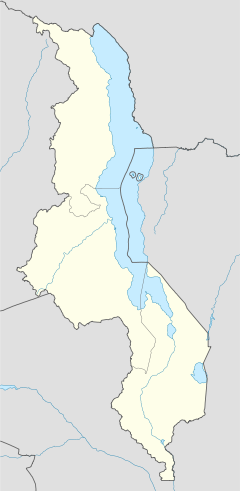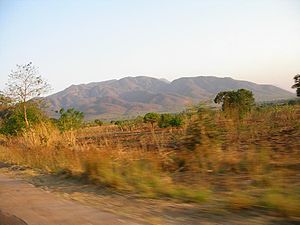
Zomba, Malawi
About this schools Wikipedia selection
This Schools selection was originally chosen by SOS Children for schools in the developing world without internet access. It is available as a intranet download. Sponsor a child to make a real difference.
| Zomba | |
|---|---|
 |
|
|
|
|
| Coordinates: 15°23′S 35°20′E | |
| Country | |
| Region | Southern Region |
| District | Zomba District |
| Population (2008 est.) | |
| • Total | 101,140 |
| Time zone | +2 |
Zomba is a city in southern Malawi, in the Shire Highlands. It is the administrative capital of Zomba District.
It was the capital of first British Central Africa and then Nyasaland before the establishment of the Republic of Malawi in 1964. It was also the first capital of Malawi and remained so until 1974, when Lilongwe became the capital. The city is best known for its British colonial architecture and its location at the base of the dramatic Zomba Plateau. Zomba is also the home of Chancellor College of the University of Malawi.
History
British colonial influence
The town's British colonial past is reflected in the architecture of its older buildings and homes. Zomba was once a hub for expatriates in Malawi. Its diverse cultural mix included British tobacco farmers and Dutch, German and U.S. emissaries. The Zomba Gymkhana Club was once the focus for social activity in the expatriate community. However, in recent years, the club's appearance and reputation have been in decline. The British also established Sir Harry Johnston Primary School.
Education
University of Malawi
Chancellor College, the largest of the constituent colleges of the University of Malawi, is located in Zomba. The college has five faculties: Faculty of Humanities, Faculty of Science, Faculty of Law, Faculty of Social Science and Faculty of Education.
Sir Harry Johnston International Primary School
Sir Harry Johnston International School has served the international and local community since the early 1950s. The school consists of a five classroom block with a hall, and separate networked IT suite and library. Within the spacious and beautifully landscaped grounds there is a swimming pool, a seventy metre soccer/games field, basketball court, nursery class play area, a volleyball court, netball field and smaller sized training pitches. The school is centrally located on Kalimbuka Road and offers an internationally adapted UK curriculum. The school has students from a diverse range of nationalities with around half of the students Malawian. The school is non-profit making and is managed by an elected board of governors from the parent community.
Zomba Catholic Secondary School
Located around 3 miles from the town centre, this is a government funded school founded in the 1940s by the Catholic church. A community of Marist Brothers is located on site and the Brothers help with the teaching. Although funded by the government, pupils are still required to pay fees (MK15000 per term as of 2011) as they live on campus and must pay board. The school is regarded as one of the best government schools in Malawi and competition for entry is intense. The school has around 300 pupils and 16 teachers as well as several administrative staff.
Geography
Zomba Plateau
The Zomba Plateau is arguably Zomba's most famous feature. In some parts, it rises to 1800m in height and is covered with vast tracts of African Juniper and Widdringtonia, and other mixed vegetation. The top of the plateau is criss-crossed by streams and is dotted with waterfalls and still lakes. The hike to the top of the Plateau is a popular tourist activity.
From the top of the plateau, it is possible to see Lake Chilwa to the north, Mount Mulanje to the southeast and the Shire River to the west.
This is a good place to trek, as there is an abundance of plantlife and creatures, as well as waterfalls.
Fauna
White-Winged Apalis - several pairs have been sighted in the evergreen forest along the Mulunguzi River, it is estimated that only 100 pairs remain in the wild.
Eastern Egg Eater (Dasypeltis medici medici) - several specimens recorded, including one of 112cm.
Transportation
The easiest way to get to Zomba is by kombi bus service from Lilongwe or Blantyre via the M1, Malawi's main north-south highway.
Demographics
| Year | Population |
|---|---|
| 1977 | 24 234 |
| 1987 | 43 250 |
| 1998 | 64 115 |
| 2008 | 101 140 |


